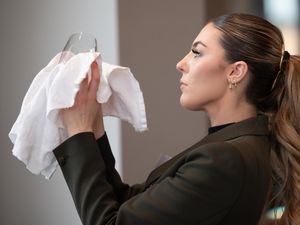Birds chirping and green walks: Taking time out to reconnect with nature
Millions of people have found solace in nature since the lockdown started.
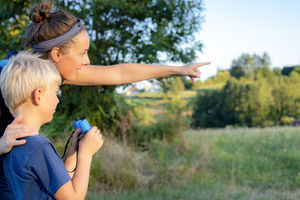
Whether it’s watching the birds chirping away in the back garden or taking a walk through the trees in a local woodland, it’s sparked a greater appreciation of our natural surroundings.
For some it’s enough just to enjoy their beauty but for others it’s nice to understand more about what it is we’re hearing, seeing and sharing our gardens and countryside with.
But if you don’t know a song thrush from a willow warbler or a cuckooflower from a foxglove, then don’t worry there are some simply ways to identify them.
The RSPB has provided a guide to the wildlife we’re most likely to see in our gardens at this time of year.
At the moment we are lucky to be able to wake up to the dawn chorus – a symphony of birdsong as our feathered friends defend their territory and call for a mate.
In your garden you might hear a blackcap, which has a warbling verse. It is a distinctive grey, the male with a black cap and the female with a chestnut one. Its delightful fluting song has earned it the name ‘northern nightingale’.
If you hear a bird singing in fast and squeaky bursts – then that’s a dunnock. It is a small brown and grey bird, quiet and unobtrusive, often seen on its own moving with a rather nervous, shuffling gait.

Robins calls in short, laid-back verses with a ‘liquid’ quality. This iconic bird is aggressively territorial and is quick to drive away intruders. Meanwhile, the song thrush has rich and confident calls. It’s smaller and browner than a mistle thrush, with smaller spotting. It has a habit of repeating song phrases distinguish it from singing blackbirds. It also likes to eat snails which it breaks into by smashing them against a stone with a flick of the head.
A willow warbler sings out with a soft, gentle whistle. They are small birds with grey-green backs and pale under parts. They have a yellow tinged chest and throat and a stripe above the eye.
Wrens are bold and loud. These tiny brown birds have a fine bill, quite long legs and toes, very short round wings and a short, narrow tail which is sometimes cocked up vertically.
A bird that makes itself easy to identify is the chiffchaff because it’s call helpfully sounds like ‘chiff chaff’. The chiffchaff is a small olive-brown warbler which actively flits through trees and shrubs, with a distinctive tail-wagging movement.
Skylarks have a pleasant burble, sometimes minutes long. It is a small brown bird, somewhat larger than a sparrow but smaller than a starling. It is streaky brown with a small crest, which can be raised when the bird is excited or alarmed, and a white-sided tail.
Great tits have a two-note ‘tee-cher tee-cher’ call. They are the largest UK tit and are green and yellow with a striking glossy black head with white cheeks and a distinctive two-syllable song.
The woodpigeon has a wonderfully recognisable ‘coo’ call. The UK’s largest and commonest pigeon, the woodpigeon is largely grey with a white neck patch and white wing patches, clearly visible in flight.
This is also a great time of year to keep an eye out for migratory birds returning to the UK and among those you might see from your house are swifts and, in late spring, swallows with their longer tail streamers.
These medium-sized aerial birds are superb fliers. They are a plain sooty brown colour but in flight against the sky will appear black. They have long, scythe-like wings and a short, forked tail. It is a summer visitor, breeding across the UK. House martins are also a common sighting. They are small birds with glossy blue-black upper parts and pure white under parts. They have a distinctive white rump with a forked tail and, on close inspection, white feathers covering their legs and toes.
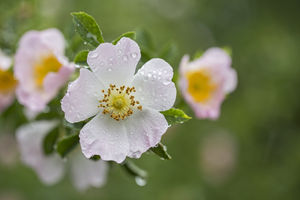
Finally, swallows are regularly seen in late spring. These are small birds with dark, glossy-blue backs, red throats, pale underparts and long tail streamers. They are extremely agile in flight and spend most of their time on the wing.
Your garden is a great place to see other wildlife from small mammals like hedgehogs and bats to butterflies and moths.
At dusk and after dark, you might spot hedgehogs snuffling and grunting as they forage for food or drinking out of a pond.
This is the time when you might also spot a common pipistrelle. These are tiny bats with reddish-brown coats and blackish-brown ears, nose and wing membranes. They are common throughout Britain and emerge at dusk to feed for a couple of hours before returning to their roosts.
It’s also not uncommon to have amphibians pay a visit to your garden.
Common frogs, smooth skin that varies in colour from grey, olive green and yellow to brown. They have irregular dark blotches, a dark stripe around their eyes and eardrum, and dark bars on their legs. They are able to lighten or darken their skin to match their surroundings.
If you have a pond, then you might be lucky to see a common newt. The are olive green or pale brown with a bright orange, black spotted underside. They are nocturnal and spend the day hiding under large stones or compost heaps.
Butterflies are some of the most obvious and beautiful insect visitors to our gardens. The RSPB says that in the UK, there are about 60 species and of these, up to 22 can be recorded outside our homes.
Painted lady butterflies are among the most common and can be seen feeding on a variety of nectar-rich flowers or basking in the sunshine.
The large skipper is a common butterfly of summer that is found where grasses grow tall while the peacock butterfly has brownish-red wings, each with a single, large peacock-feather-like eyespot – used to scare predators.
It can be seen feeding on a variety of flowers, basking in the sunshine and in woodlands, parks and hedgerows.
If you’re leaving your home and heading outdoors, then now is the time to see some of Britain’s most beautiful wildflowers.
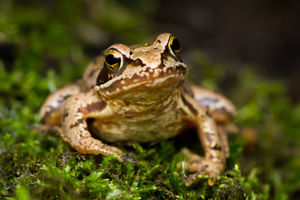
Between now and July, Dog Rose has large pink or white flowers with five petals and many stamens that have a faint sweet smell.
Kingcup, also known as Marsh Marigold, has large, golden yellow flowers and favours damp spots, like ponds, meadows, marshes, ditches and wet woodlands.
Cuckooflower has pretty lilac flowers and is at its best this month. It grows wherever there is damp ground but it may also found on road verges and in ditches.
Foxgloves are a well-known wild flower with tall spikes which can bear up to 80 bell-shaped blooms. They are typically found in woodland clearings and along hedgerows and banks.
During lockdown, Staffordshire Wildlife Trust has been encouraging people to make the most of the nature on their doorstep.
“Nature is a source of both joy and solace, but you don’t have to go far to experience the wonders it brings,” says senior conservation manager Jeff Sim.
“If you do have a garden, we’d encourage you to spend more time in it than before and look for wildlife. It’s the perfect time to make sure your garden birds are fed, look for emerging bees and butterflies, to make a wildlife pond or leave part of the garden wild to help insects and a whole host of other species.
“If you do go for a daily walk, even if you don’t have green spaces close by, you can always hear birds chirping away, take in fresh air and look up towards the clouds to get your dose of the natural world.
“There is so much to do and see, and you don’t have to go far to experience the wonders it brings.”
While you’re out and about enjoying green spaces and fresh air, the RSPB says it’s important to stay alert for nature.
For most UK species, breeding season is now in full swing and wildlife is at its most vulnerable point of the year.
Countryside birds, mammals and reptiles will normally avoid busier areas of human activity to ensure their nests and young are safe from accidental harm, steering clear from popular beaches, busy footpaths or dog walking hot spots.
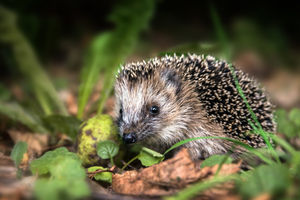
But with so many people confined to their homes, the country’s wildlife may have moved into spaces they would usually keep away from.
“This year, nature hasn’t needed to adapt to human behaviour, as we stayed home, and some of our wildlife has reclaimed the places we’ve temporarily given up. As we head back out, we need to be alert and avoid disturbing nature as it gets on with producing the next generation,” says the RSPB’s Director of England, Emma Marsh.
An example of nature reclaiming space is grassland outside Oswestry Police Station which has grown into a beautiful wildflower meadow.
Usually mown every couple of weeks, the lawn has been untouched for over a month. Cowslips, pignut, ox-eye daises, bugle, germander speedwell, thyme-leaved speedwell, creeping cinquefoil and sweet vernal grass are flourishing as a result.
“This is very likely an old meadow, undisturbed – apart from mowing – for generations. These plants have now had a chance to flower, which is wonderful. I hope very much that they will be left for a few more weeks, so they can set seed and spread,” said Sarah Gibson, a local resident and spokesperson for Shropshire Wildlife Trust.
As we ease out of lockdown and get back even further into the countryside, the RSPB has some advice on how we can help wildlife to thrive.
The first rule is to stay alert. “Any habitat can be a home for wildlife and many of our most vulnerable species are very good at hiding themselves in plain sight. Beaches are home to threatened ground nesting birds like little terns and ringed plover, while seals have been choosing to rest at popular spots during lockdown. Even the grass verges next to paths could be hiding skylark or meadow pipit chicks,” says Emma.
The RSPB also recommends sticking to paths and bridleways as this is the simplest way to give nature the space it needs.
Keeping dogs on leads in the open countryside is also essential.
“They might be man’s best friend but for vulnerable chicks, a dog bounding through a nest can pose a real threat. Keeping your dog on a lead in the open countryside will help protect both wildlife and livestock. Heathlands are home to ground nesting rare nightjar and woodlark, which can be easily disturbed by dogs off leads,” says Emma.
Nature can be unpredictable which means you might be doing everything you can to keep birds and animals safe, but you might still end up disturbing a breeding species.
The best thing to do is to immediately back away so they don’t get too anxious and agitated.
“Short, sharp alarm calls, birds with full beaks or coming unusually near to you usually mean you are too close to young, which can often be very well hidden even if they are almost underfoot. If you see any of this behaviour, you should back up the way you came to avoid any risk of disturbing or injuring young, being careful to watch where you tread,” says Emma.
Finally, the charity wants us all to be on the look out for any bad behaviour and if we notice anything suspicious going on in our local countryside, such as evidence of wildlife crime, fly-tipping or uncontrolled fires, then it can be reported to the local wildlife crime officer using the police 101 number.

